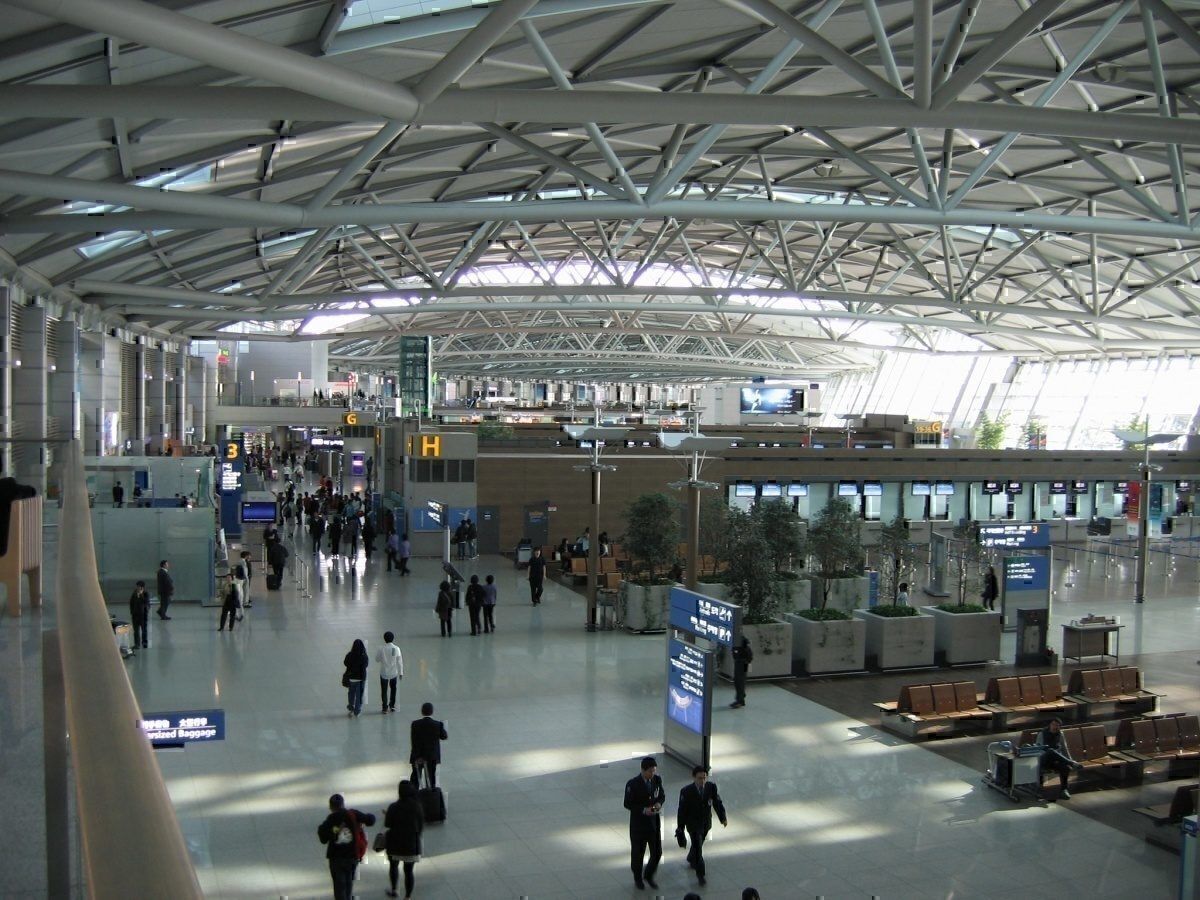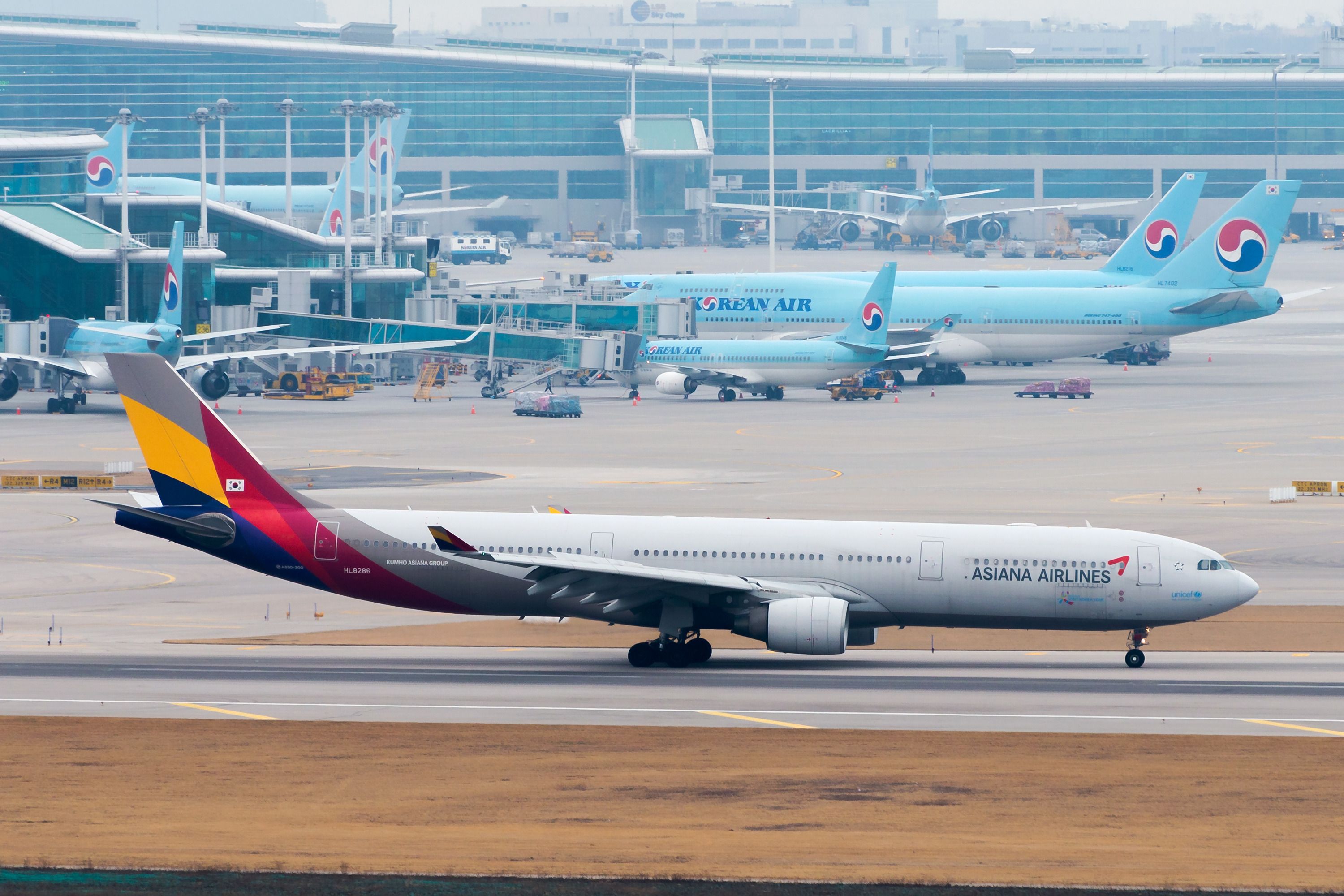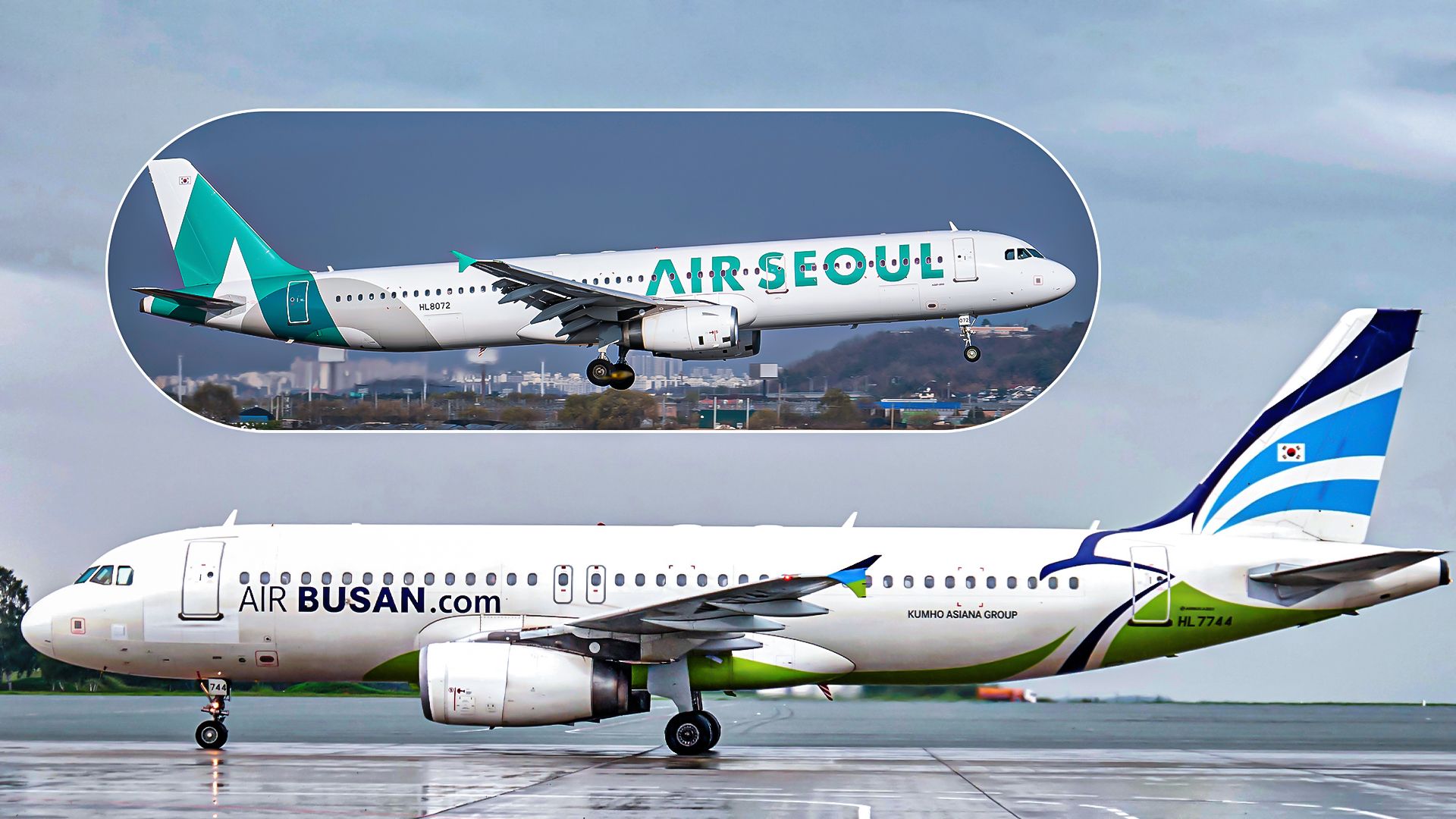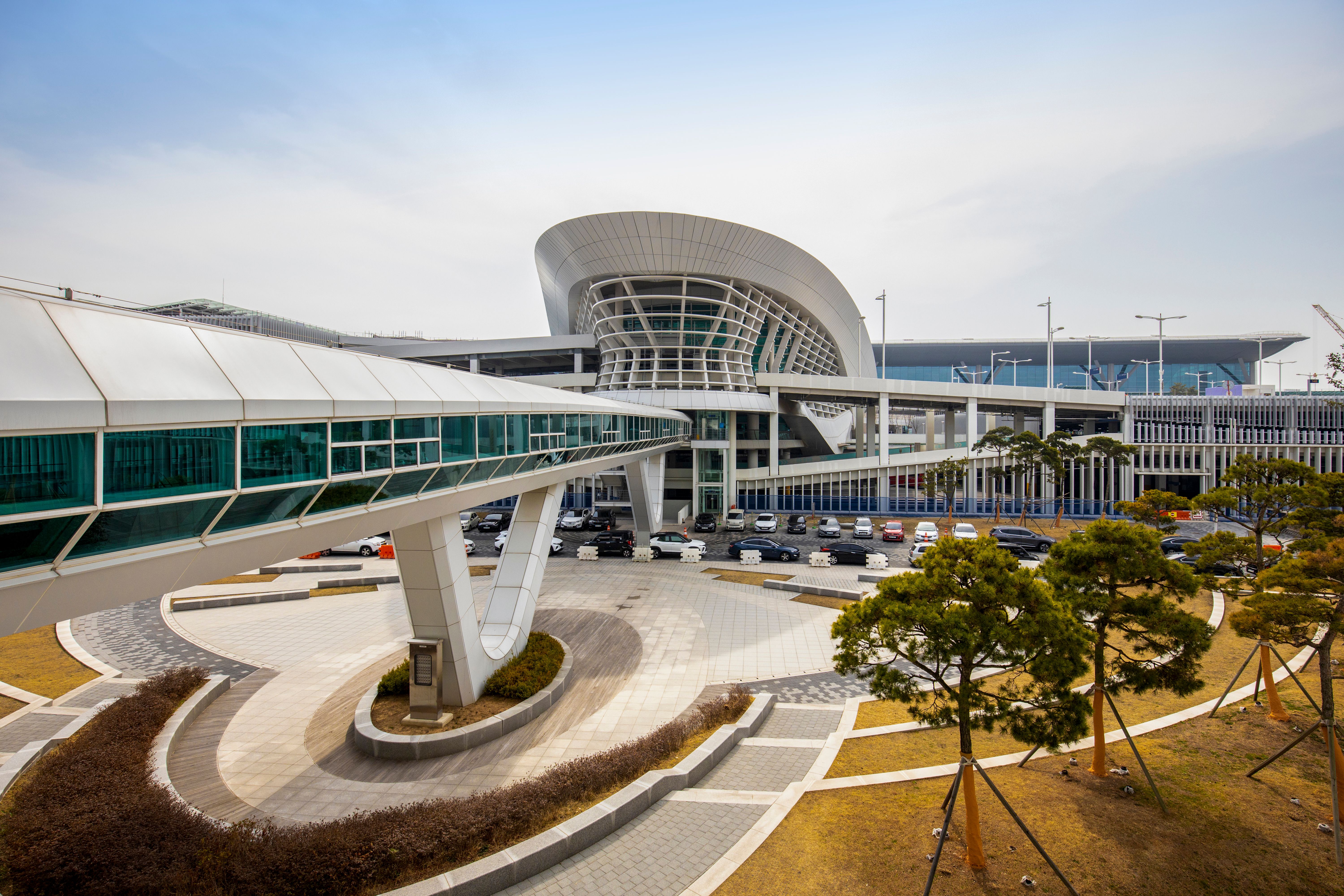Summary
- Air Seoul focuses on leisure travelers with efficient Airbus A321-200 fleet, offering straightforward service with optional add-ons.
- Air Busan operates a mixed fleet including A320-200, A321-200, A321neo, and A321LR, known for comfortable seating and complimentary services.
- Asiana Airlines’ merger with Korean Air aims strengthen the airlines and enhance Air Seoul and Air Busan’s route networks and services, though specific details still need to be worked out.
Asiana Airlines, one of South Korea’s premier carriers, operates two low-cost subsidiaries: Air Seoul and Air Busan. These budget airlines play a crucial role in expanding Asiana’s network and offering cost-effective travel options. Here’s everything you need to know about these airlines, from their history to their route networks and fleet details.
Air Seoul
History and overview
Air Seoul, established in 2015, is a wholly-owned subsidiary of Asiana Airlines. The airline was launched to counter the increasing competition from other low-cost carriers (LCCs) in South Korea and to optimize Asiana’s route network by focusing on leisure travelers. Based at Incheon International Airport (ICN), Air Seoul offers both domestic and international flights.
Photo: Stock for you | Shutterstock
Fleet and services
Air Seoul operates a fleet of Airbus A321-200 aircraft, known for their efficiency and suitability for short to medium-haul flights. As of the latest data from Cirium, an aviation analytics company, Air Seoul has a fleet of 6 Airbus A321-200 aircraft. Each A321-200 is configured to seat between 195 and 220 passengers in an all-economy layout. The airline emphasizes affordability while maintaining quality service, offering a straightforward in-flight experience with optional add-ons for baggage, meals, and seat selection.
Photo: Parkdolly | Shutterstock
Top 5 routes
Based on the latest data from Cirium, here are the top 5 routes for Air Seoul by number of flights, seats, and Available Seat Miles (ASM):
Incheon International Airport (ICN) ⇔ Narita International Airport (NRT)
- Number of Flights (YTD): 1,338
- Total Seats (YTD): 260,910
- Available Seat Miles (ASM, YTD): 204,553,440
- Projections for August 2024: 196 flights, 38,220 seats, 29,964,480 ASM
Gimpo International Airport (GMP) ⇔ Jeju International Airport (CJU)
- Number of Flights (YTD): 1,287 T
- Total Seats (YTD): 283,140
- Available Seat Miles (ASM, YTD): 78,996,060
- Projections for August 2024: 248 flights, 54,560 seats, 15,222,240 ASM
Incheon International Airport (ICN) ⇔ Kansai International Airport (KIX)
- Number of Flights (YTD): 1,282
- Total Seats (YTD): 249,990
- Available Seat Miles (ASM, YTD): 133,994,640
- Projections for August 2024: 194 flights, 37,830 seats, 20,276,880 ASM
Incheon International Airport (ICN) ⇔ Fukuoka Airport (FUK)
- Number of Flights (YTD): 850
- Total Seats (YTD): 165,750
- Available Seat Miles (ASM, YTD): 58,012,500
- Projections for August 2024: 124 flights, 24,180 seats, 8,463,000 ASM

Related
Is Seoul Incheon The Most Competitive Hub Airport?
Air Busan
History and overview
Air Busan, founded in 2007 as Busan International Airlines Company, is another key player in Asiana’s portfolio. Originally a joint venture between Asiana Airlines and local businesses in Busan, it quickly grew to become a significant low-cost carrier in the region. Headquartered in Busan, the airline primarily operates out of Gimhae International Airport (PUS).
Photo: Sorbis | Shutterstock
Fleet and Services
Air Busan operates a mixed fleet, including:
- Airbus A320-200: Seating 180 passengers in their current configuration.
- Airbus A321-200: Configured to seat 195 to 220 passengers in their current layouts.
- Airbus A321neo: Offering improved fuel efficiency and longer range, seating 232 passengers in their current configuration.
- Airbus A321LR: Seating 220 passengers in their current layout.

As of the latest data from Cirium, Air Busan operates a fleet of 24 aircraft, which includes 6 Airbus A320-200, 10 Airbus A321-200, 4 Airbus A321neo, and 4 Airbus A321LR aircraft. The airline is known for its comfortable seating arrangements and the provision of complimentary services, such as in-flight entertainment and a selection of free beverages, distinguishing itself slightly from the typical low-cost carrier model.
According to the Ministry of Land, Infrastructure and Transport, Air Busan retired 7 former Asiana Airlines fleet aircraft in 2016: 4 Boeing 737-400s and 3 Boeing 737-500s. They retired an additional 2 Airbus A320-200s in 2022 and 7 Airbus A321-200s in 2023.
Top 5 routes
Based on the latest data from Cirium, here are the top 5 routes for Air Busan by number of flights, seats, and ASM:
Gimhae International Airport (PUS) ⇔ Fukuoka Airport (FUK)
- Number of Flights (YTD): 1,740
- Total Seats (YTD): 382,272
- Available Seat Miles (ASM, YTD): 53,900,352
- Projections for August 2024: 256 flights, 55,396 seats, 7,810,836 ASM
Gimhae International Airport (PUS) ⇔ Kansai International Airport (KIX)
- Number of Flights (YTD): 1,326
- Total Seats (YTD): 292,874
- Available Seat Miles (ASM, YTD): 106,313,262
- Projections for August 2024: 201 flights, 41,590 seats, 15,097,170 ASM
Incheon International Airport (ICN) ⇔ Kansai International Airport (KIX)
- Number of Flights (YTD): 1,278
- Total Seats (YTD): 285,700
- Available Seat Miles (ASM, YTD): 153,135,200
- Projections for August 2024: 186 flights, 41,520 seats, 22,254,720 ASM
Incheon International Airport (ICN) ⇔ Fukuoka Airport (FUK)
- Number of Flights (YTD): 852
- Total Seats (YTD): 195,648
- Available Seat Miles (ASM, YTD): 68,476,800
- Projections for August 2024: 124 flights, 28,624 seats, 10,018,400 ASM
Gimhae International Airport (PUS) ⇔ Taoyuan International Airport (TPE)
-
Number of Flights (YTD): 606Total Seats (YTD): 134,402
- Available Seat Miles (ASM, YTD): 112,091,268
- Projections for August 2024: 124 flights, 28,140 seats, 23,468,760 ASM
Incheon International Airport (ICN) ⇔ Narita International Airport (NRT) flew more flights YTD than Gimhae International Airport (PUS) ⇔ Taoyuan International Airport (TPE) but the Projections for August 2024 are slightly higher on the PUS ⇔ TPE route.
Incheon International Airport (ICN) ⇔ Narita International Airport (NRT)
Number of Flights (YTD): 852
Total Seats (YTD): 188,482
Available Seate Miles (ASM YTD): 147,769,888
Projections for August (2024): 124 flights, 27,748 seats, 21,613,312 ASM
Asiana Airlines’ merger with Korean Air
In a significant development for South Korean aviation, Asiana Airlines is set to be absorbed by Korean Air. This merger aims to create a stronger and more competitive airline capable of standing up to other global carriers. The integration of Air Seoul and Air Busan into this new entity is expected to enhance the overall route network and service offerings, though specific details are still being worked out.

Related
Korean Air & Asiana Merger: What’s The Latest?
Four routes to Europe and its cargo unit are expected to be sold, paving the way for the European Unions antitrust approval.
Wrapping it up
Air Seoul and Air Busan are integral to Asiana Airlines’ strategy, offering budget-friendly travel options without compromising too much on service quality. With extensive domestic and international networks, these subsidiaries provide reliable and affordable options for travelers. The upcoming merger with Korean Air promises to further enhance the capabilities and reach of these low-cost carriers, ensuring they remain competitive in the dynamic asian aviation market.




